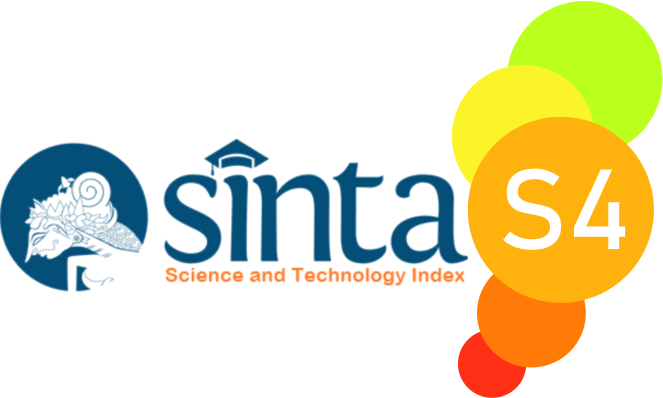Developing Vocabulary Animation Game Application for Pronounciation at Pelita Kasih Lawang Kindergarten
Abstract
The purpose of developing illustrated vocabulary animation game media for kindergarten – A students at Pelita Kasih Lawang Kindergarten is that early childhood can concentrate and understand the content of the material so that they are able to repeat simple words with correct pronunciation. Early childhood is also expected to be able to repeat words that have been listened to friends and teachers. Researchers compiled an animated vocabulary game media developer pictured in learning English, by making a Research and Development (R&D) development research design, which is research used to produce certain products, and test the validity of these products. This Research and Development procedure is an adaptation of Sugiono's theory (2011 : 297), namely : 1) Potential and Problems, 2) Data Collection, 3) Product Design, 4) Design Validation, 5) Usage Trial, 6) Product Revision, 7) Product Trial, 8) Design Revision. Product Trial, 8) Design Revision. The data analysis technique used is qualitative and quantitative analysis in the form of percentages. The results of this research and development obtained are : 94.44% of the learning expert validation results, 96.15% of the media expert validation results, 91.11% of the small group trial results, and 95.68% of the field trial results. Based on these results, the development of animated media in language learning is classified as feasible to use. Based on the validation results, observations on small group trials and field trials, it can be concluded that the development of animated media in language learning is very interesting, fun, and easy to use. It is hoped that the results of the development of animated media in language learning can be developed even better, more effective, and right on target. So that it can be utilised according to the needs and achieve the goals of early childhood language learning.
References
Arsyad, Azhar. (2011). Media Pembelajaran. Jakarta: Raja Grafindo Persada.
Depdiknas. 2003. Undang-undang Republik Indonesia nomor 20 tahun 2003 tentang Sistem Pendidikan Nasional. Jakarta.
Depdiknas. 2009. Peraturan Menteri Pendidikan Nasional Republik Indonesia nomor 58 tahun 2009 tentang Standar Pendidikan Anak Usia Dini. Jakarta.
Hana. 2011. Terapi Kecerdasan Anak Dengan Dongeng, Yogyakarta: Berlian Media.
Hurlock. 1980. Psikologi Perkembangan. Jakarta: Penerbit Erlangga.
Moeslichatoen.2004.Metode Pengajaran.Jakarta: PT Rineka Cipta.
Mulyasa.2012. Manajemen PAUD. Bandung: PT Remaja Rosdakarya.
Salam. 2010. Animasi Kartun. Jakarta: PT Indeks.
Salkind. 2009. Teori-Teori Perkembangan Manusia. Bandung: Penerbit Nusa Media.
Sudijono. 2010.Pengantar Statistik Pendidikan.Jakarta: PT Raja Grafindo Persada.
Sudjana. 2012. Penilaian Hasil Proses Belajar Mengajar. Bandung: PT. Remaja Rosdakarya.
Sugiyono. 2011.Metode Penelitian Kuantitatif Kualitatif dan R & D.Bandung: Alfabeta.
Universitas Negeri Malang. 2010. Pedoman Penulisan Karya Ilmiah. Malang : Penerbit Universitas Negeri Malang.
Yamin & Sanan, 2008. Panduan Pendidikan Anak Usia Dini,Jakarta : PT Indeks.
Yamin & Sanan, 2010. Pendidikan Anak Usia Dini, Jakarta : Gaung Persada (GP) Press Jakarta.
Yus. 2011.Model Pendidikan Anak Usia Dini.Jakarta : Kencana Prenada Media Group.
Aisyah Isna.2019. Perkembangan Bahasa Anak Usia Dini.
(https://ejournal.stainupwr.ac.id/) accessed on 9th June 2022 at 11 pm.
Animia, 2010. Pengertian Animasi dan Konsep Pembuatan Animasi,(Online) (http://animia.mywapblog.com/pengertian-animasi-dan-konsep-pembuatan.xhtml) accessed on 11th May 2022 at 9 pm.
ER. Amalia. Meningkatkan Perkembangan Bahasa Anak Usia Dini Dengan Metode Bercerita (https://osf.io/kr5fw/download) accessed on 9th June 2022 at 12 pm.
Febrianiutami0711. 2012. Karakteristik Perkembangan Anak Usia Dini. (Online) (http://febrianiutami0711.wordpress.com/2012/12/17/karakteristik-perkembangan-anak-usia-dini/) accessed on 11th May 2022 at 9 pm.
https://eprints.uny.ac.id/23896/4/4.%20BAB%20II.pdf (accessed on 18th May 2022 at 9 pm.)
https://eprints.uny.ac.id/9809/3/BAB%202%20-08108244022.pdf (accessed on 18th May 2022 at 9 pm.)
https://lib.unnes.ac.id/24027/1/1102411080.pdf (accessed on 18th May 2022 at 9 pm.)
Kamriantiramli. 2011. Media Animasi untuk Siswa, (Online) (http://kamriantiramli.wordpress.com/tag/kelebihan-dan-kekurangan-media-animasi/ ) accessed on 30th May 2022 at 9 am.
Much Deiniatur.2017. Pembelajaran Bahasa Pada Anak Usia Dini Melalui Cerita Bergambar (https://core.ac.uk/download/pdf/235260357.pdf) accessed on 15th June 2022 at 10 pm.
Marini. 2009.Pengertian Animasi, (Online). (http://marinishadrina.blogspot.com/2009/10/pengertian-animasi.html) accessed on 18th May 2022 at 9 pm.
Pustakapaud. 2016. Perkembangan Bahasa Anak Usia 4 - 5 Tahun
(https://pustakapaud.blogspot.com/2016/10/perkembangan-bahasa-anak-usia-4-5-tahun.html) accessed on 1th June 2022 at 12 pm.
Perkembangan Bahasa - Staff UNYstaffnew.uny.ac.id (accessed on 9th June 2022 at 11pm.)
Yudha,Q.2012.Pengertian dan Jenis Jenis Animasi, (Online). (http://clickyudhaqirana.wordpress.com/2012/03/29/pengertian-dan-jenis-jenis-animasi/) accessed on 9th June 2022 at 10 am.
Copyright (c) 2022 Christina Retna Ningrum, Trisnian Ifianti, Adi Adi

This work is licensed under a Creative Commons Attribution-ShareAlike 4.0 International License.

Journey: Journal of English Language and Pedagogy by http://ejurnal.budiutomomalang.ac.id/index.php/journey/index is licensed under a Creative Commons Attribution-ShareAlike 4.0 International License.






